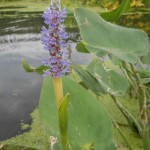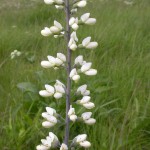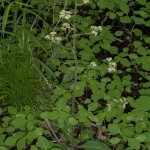YOUR DAILY DOSE OF BOTANY – DECEMBER 2015
Inflorescence Types Part I
by Scott Namestnik, snamestnik@orbisec.com
We investigated the great diversity in corolla types in this column of The Plant Press in fall 2014 through spring 2015. Now it’s time to see how the individual flowers on a plant are arranged into the structure known as the inflorescence. As you would expect, there are numerous types of inflorescences, and each of those has a unique name to better help botanists describe the characteristics of plants. To begin our discussion of inflorescences, we’ll start with the three most simple inflorescence types.
When the individual flowers in an inflorescence are stalkless and arranged along an elongated and unbranched axis, the inflorescence is called a spike. The axis of the inflorescence on which the flowers are borne is called the rachis. The inflorescence of the beautiful wetland plant pickerel weed (Pontederia cordata) is a spike.
A raceme is very similar to a spike, but instead of having stalkless flowers, each flower is on a stalk. The stalk of each individual flower is called a pedicel. Racemes and spikes are said to be indeterminate, which means that the oldest flowers are at the base of the raceme and the youngest flowers are at the apex; the inflorescence length continues to expand as it develops. A determinate inflorescence, by contrast, is one that has the oldest flowers at the apex, meaning that the inflorescence length is defined prior to flowering. The inflorescence of the charismatic mesic prairie legume white wild indigo (Baptisia alba) is a raceme.
In a panicle, not only are the individual flowers stalked, but the stalks are on a stalk as well. A panicle can be thought of as a compound raceme. Another way to think about it is that a panicle consists of several racemes that have a shared axis; or, the stalks of the flowers in a panicle do not connect directly to the
rachis of the inflorescence. An example of a plant that has an inflorescence that is a panicle is swamp saxifrage (Micranthes pensylvanica), an uncommon plant that often grows in wetlands with groundwater influence.
If you have a question about plant terminology or morphology that you would like answered in a future edition of this column, send me an email at snamestnik@orbisec.com. I may not be able to address all requests given the space allotted for this column, but I will answer those that I can.



